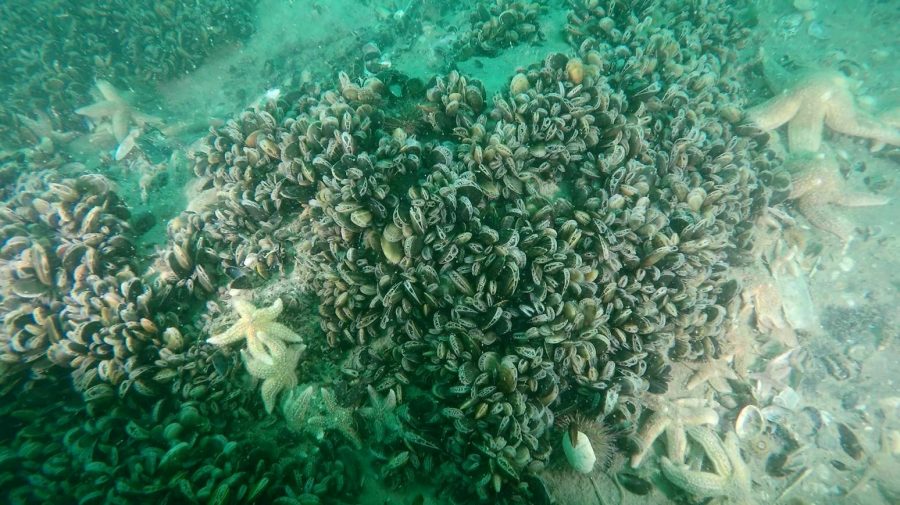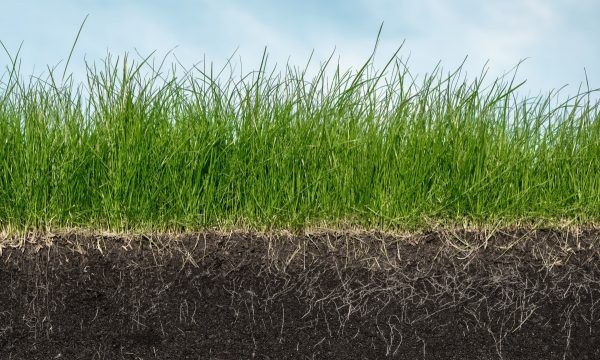Press release Counteracting coastal erosion with natural reefs?

The scientific project 'Coastbusters' will receive follow-up funding to further explore the possibility of deploying living, natural coastal management to protect coastal zones.
Over the past three years, interesting tests have been carried out with THREE living organisms: seaweed and seagrass beds, mussel beds and mason worms as reinforcements for the low-water line. The findings around these three lines of thought have been filmed and summarized in this document. (The images may be used in the press, in consultation with ILVO).
Watch the video about Coastbusters below
Experiments in the North Sea now focus on cleverly constructed mussel beds.
Coastbusters 2.0 is now working on one track: the feasibility of mussels as a bio-builder. How can you optimally induce mussel beds, starting from the mussel larvae? And how can you get the starting mussel beds to grow firmly together on the seabed?
This project was financed by VLAIO (Flemish Agency for Innovation and Entrepreneurship) as part of the innovation roadmaps of the spearhead cluster the Blue Cluster. The research partners are the Flemish dredging companies DEME and Jan De Nul, the technical textile company Sioen and the public research institutes ILVO and VLIZ.
Ambitious goal
In the last few weeks, Flanders (Belgium) was confronted with several heavy windstorms. From Ciara over Dennis to Ellen, they were one challenge after the other to preserve our coastline
With Coastbusters we have the ambition to reduce the sand erosion on our coastline so that less sand suppletion is needed after storms. This unique collaboration between the business community and our knowledge institutes is therefore rightly receiving Flemish support once again.
Flemish Minister of Innovation Hilde Crevits: With Coastbusters we have the ambition to reduce the sand erosion on our coastline so that less sand suppletion is needed after storms. This unique collaboration between the business community and our knowledge institutes such as VLIZ and ILVO is therefore rightly receiving Flemish support once again. With this project we are working together on innovative and natural coastal defense'.
The Coastbusters partners believe that natural reefs - if expertly located and managed - can help stabilize sea sand and soften incoming waves. The coast may therefore be better and more sustainably protected during major storms.
The seas and oceans can sometimes spontaneously develop bio-systems that have a clear coastal defensive effect. So the question is whether, and if so how, such natural coastal defenses can be applied to the desired vulnerable zones and stimulated to maintain themselves,' says Jan Seys (VLIZ).
Coastbusters will also look at the impact on biodiversity and the marine ecosystem during the experiments. Daan Delbare (ILVO): 'We assume that a coastal defense system that incorporates bio-builders will yield measurable ecological benefits.
Climate change as a driver
Coastal areas are under increasing pressure due to the changing climate. The sea level is rising and more extreme weather conditions (storms and heavy rains) are more frequent. All kinds of human activities (e.g. construction works) have also reduced the natural resilience of coastal ecosystems.
Jan Fordeyn (Jan DeNul): 'In the future, traditional solutions for coastal defense such as dikes, breakwaters and groynes on their own will not protect us sufficiently against beach erosion. It is not sustainable to keep raising these defenses endlessly to contain the risk of flooding. They're also very expensive, and they have a disruptive effect on the coastal environment."
Tomas Sterckx (DEME and project leader Coastbusters 2.0): 'Natural coastal defense systems with so-called bio-builders form an ecologically sound and intelligent alternative to the classic hard structures.
At present, however, such natural coastal defense systems are still in their infancy.
From Coastbusters...
The first Coastbusters project studied the strengthening behavior of three living organisms in the North Sea. The experiments took place in De Panne (mussels and seaweed and a first test with mason worms) and in Bredene, Heist and Lombardsijde (mason worms).
- Seaweed. Seaweed was pre-seeded on textile mats which were then placed on the seabed. During the pilot trials, the harsh conditions in the North Sea proved to hamper the smooth development of a seaweed reef. Bert Groenendaal (Sioen): 'Sioen is looking for opportunities to continue this research track.’
- Mason worms (Lanice conchilega) on the low tide strip (= the beach that falls dry at low tide). Mason worms are known to be able to stabilize loose sediment from a wet sandy beach with their 20-30cm long body in the 60cm+ long vertical tube housings located one next to the other. The question was how to lure the mason worm larvae floating in the water to settle on a particular stretch of sand and stay there for the rest of their lives.
Alexia Semerano (ILVO). The larvae must be able to hold on with their tentacles to an already existing tube, or to a shell or other object. In this research several kinds of textile mats have been offered to the larvae, both in the aquaculture lab of ILVO and in the experimental field outside. Some mats were indeed found to be suitable for induced colonization by the mason worms'.
Never before have there been such tests in the field. And never before have Lanice been successfully kept and bred in captivity, in order to be able to organize tests on larval settlement in the controlled environment of a wet lab.
'There is still a lot of study work to be done before mason worms successfully colonize large areas at the low-water line on a large scale. ILVO is looking into how the developments with Lanice can be continued. - Shellfish reefs with blue mussel (Mytilus edulis): The first experiments with artificially induced mussel beds received a remarkably favorable evaluation. The tested method of rapidly growing a mussel bed using adapted aquaculture techniques proved to work very well. In addition, initial observations indicate that the incipient mussel bed does indeed increase biodiversity.
...to Coastbusters 2.0
Coastbusters 2.0 is currently in a start-up phase. The project will focus on the most promising slope, i.e. mussel beds as a living coastal buffer against storms.
In concrete terms, the researchers are looking for answers to these questions:
- How can the mussels be better fixed on the bottom, after they have dropped off of seeded ropes hanging in the water?
- To what extent do mussel beds affect the surrounding seabed?
- What is the critical surface area and modulability of such a system?
- What interventions help the formation and survival of artificial mussel beds?
- To what extent can biodegradable materials be used?
- What is the added value of reefs in terms of biodiversity and ecosystem services?
Compared to previous experiments, Coastbusters 2.0 extends its test area to two zones. One test reef is located 2 km off the coast, behind a sandbank, in less severe weather conditions. One is further out to sea, 5 km beyond a sandbank, where there are harsher weather conditions. This allows us to compare the formation and perpetuation of the mussel reef in the various environments.
Cooperation between industry and science stimulates innovation
Biogenic reefs that will manage coastal erosion in a more sustainable way are very innovative as a concept. They are an important addition to our arsenal of sustainable techniques in hydraulic engineering, say the industrial Coastbusters partners.
Tomas Sterckx (DEME, project coordinator): 'We expect that the insights gained from our pilot tests will lead to a competitive valorization of sustainable techniques for the industrial partners involved, also internationally. The partners generate an exceptional knowledge package'.
The cooperation between industry and science is a win for the industrial partners and the public research centers.
Caroline Ven (Blue Cluster): "Coastal defense is one of the major challenges for the blue economy in the coming decades. Climate change calls for measures that will better protect us from the effects of rising sea levels and more violent storms. The partners of the Blue Cluster work side by side for innovative, sustainable solutions".




